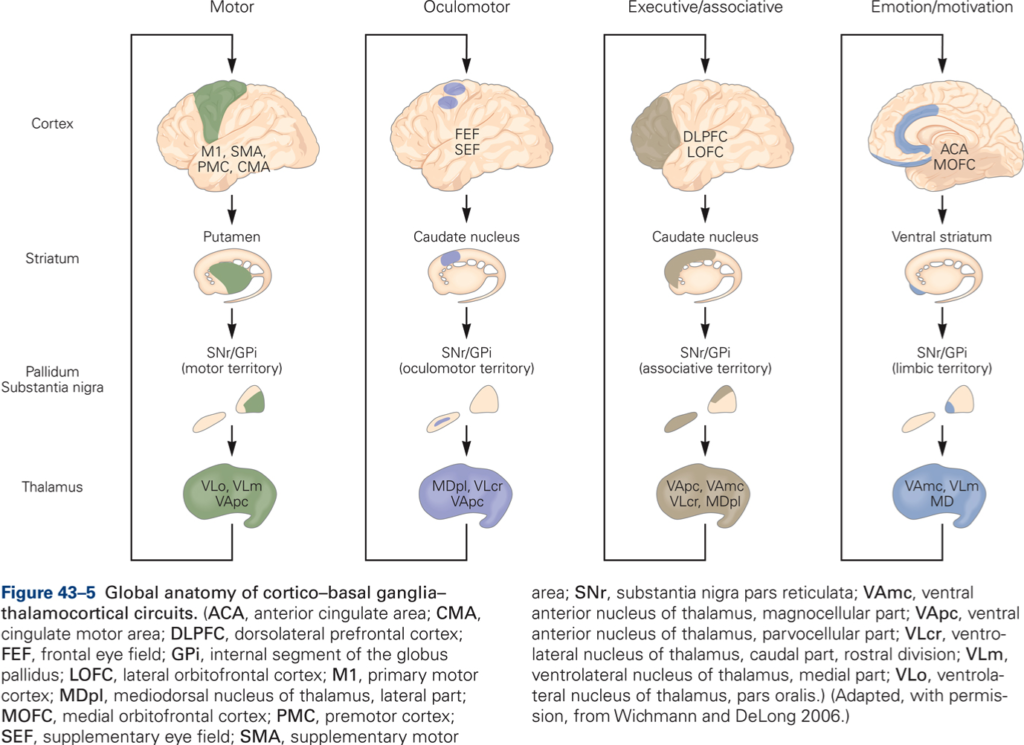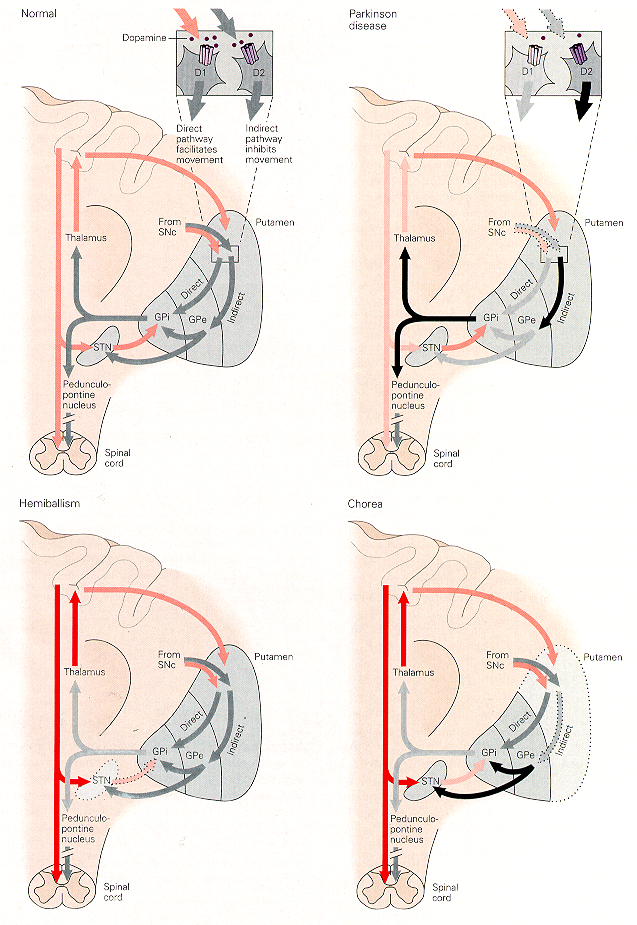Neural Control of Movement
Basal ganglia
The basal ganglia (BG) are a group of five anatomically connected and functionally related nuclei: caudate, putamen, globus pallidus (internal, GPI & external, GPE), subthalamic nucleus (STN), substantia nigra pars reticulata (SNPR), and substantia nigra pars compacta (SNPC). They receive input from all areas of cerebral cortex and link this input via relays in the thalamic nuclei to prefrontal, premotor and motor areas of cerebral cortex.
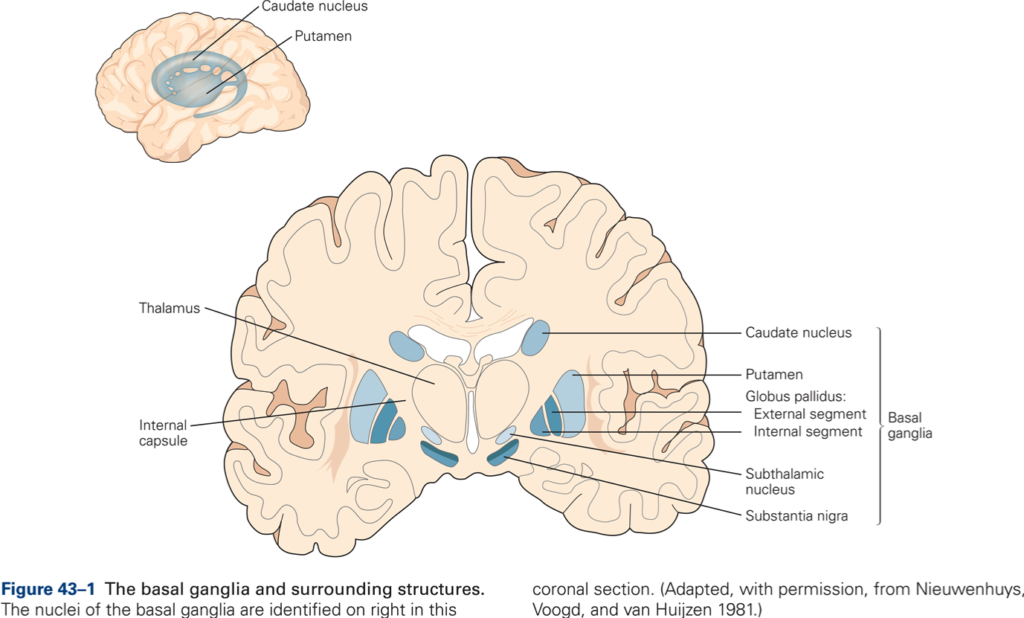
Basic circuitry
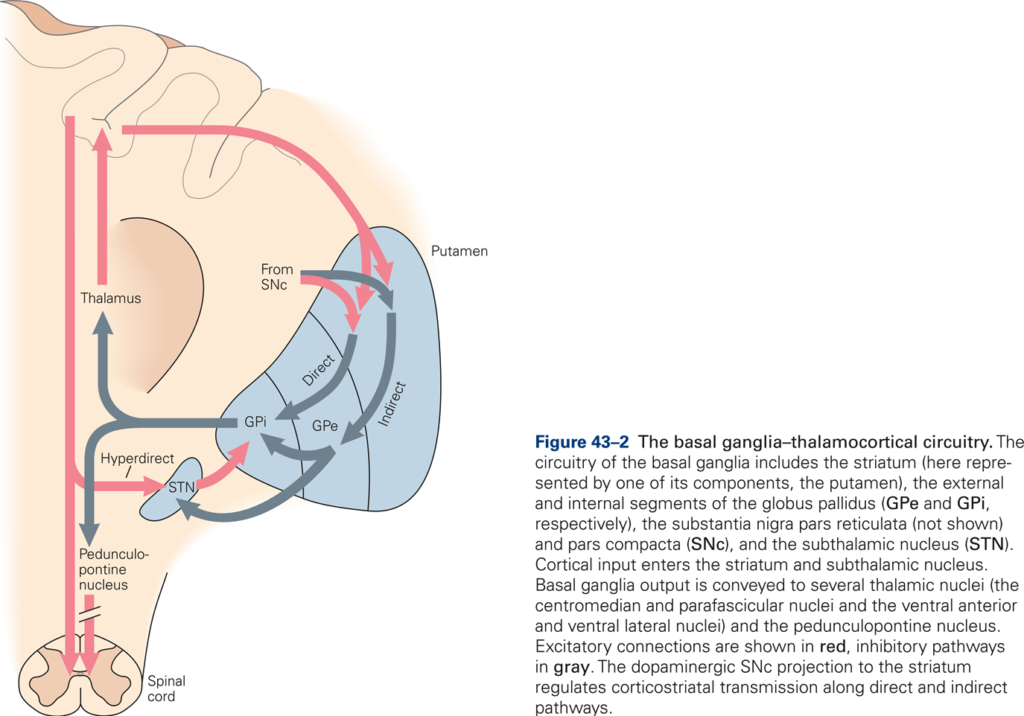
Caudate and putamen (striatum or neostriatum) are input nuclei. The putamen receives somatotopically organized input from primary motor and somatosensory cortices and from the premotor areas whereas the caudate nucleus receives input primarily from association areas of cerebral cortex. Therefore, the circuits through the caudate are involved more in higher mental functions and cognitive aspects of movement whereas the circuits through the putamen are involved more directly with the control of movement.
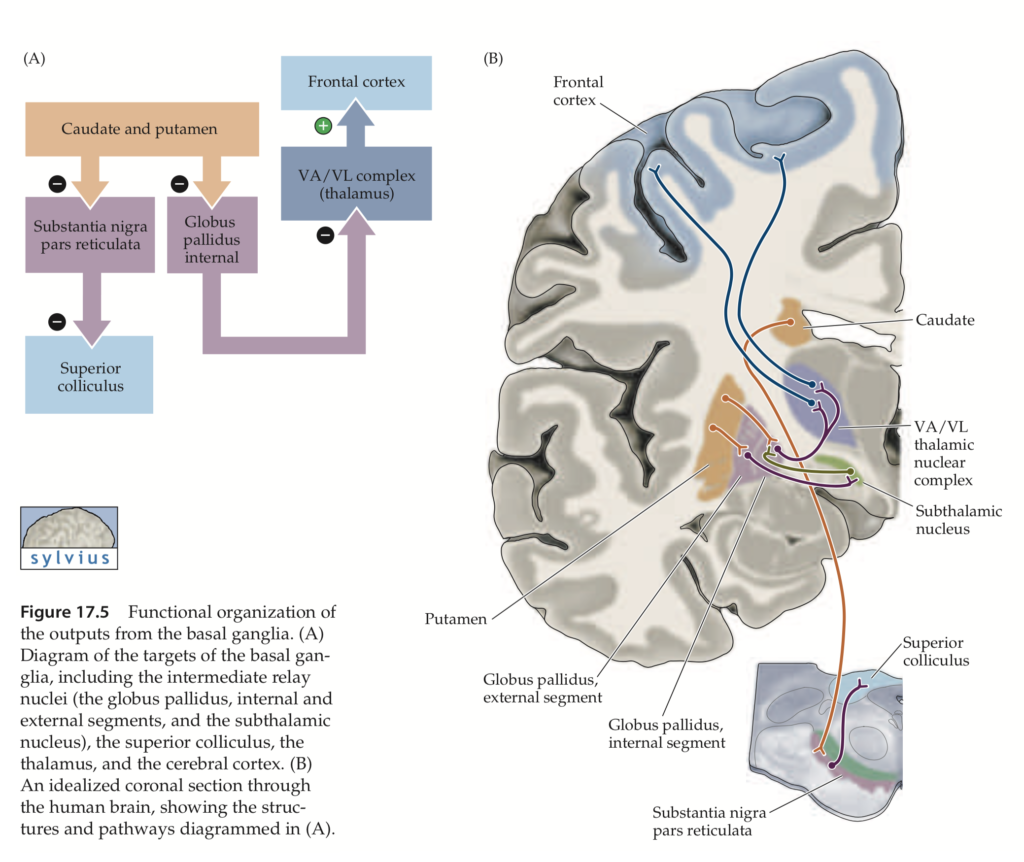
GPI and SNPR are the major output nuclei of the BG. Connections between input and output nuclei of the BG are organized the same for each of the major circuits through the BG. A direct pathway is distinguished from an indirect pathway. In the direct pathway, excitatory cortical input to the striatum produces disinhibition (i.e. two inhibitory synapses) of the thalamus, thus produces excitation at the cortex. The indirect pathway has the opposite effect.
Functional organization
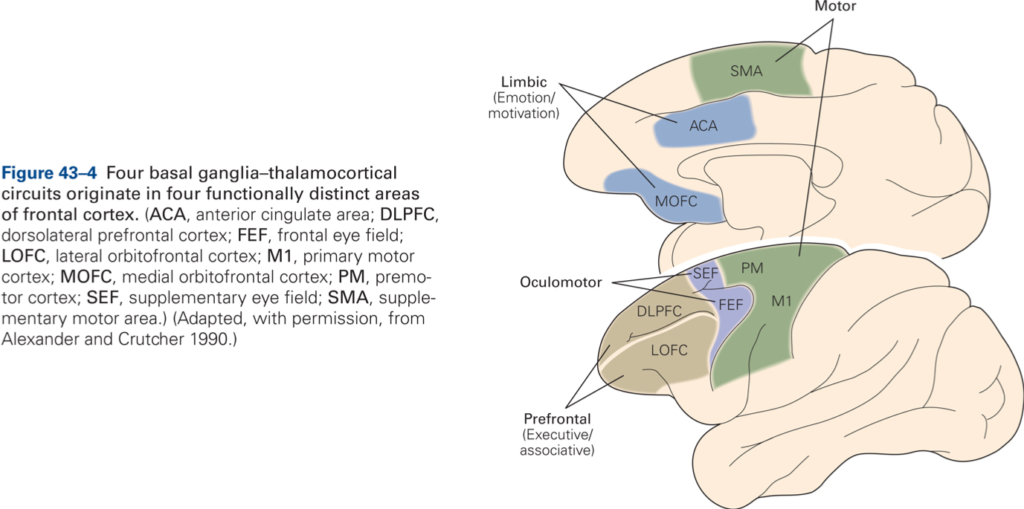
The BG consist of multiple parallel circuits in which the flow of information is kept segregated. Thus the BG process information in parallel rather than primarily integrate information from large parts of cerebral cortex.
Motor circuit
Sensorimotor areas (area 1-7) –> putamen –> GPI/SNPR –> VL thalamus –> SMA and PM
- Planning and execution of complex movement sequences.
- Planning and triggering self-initiated movements
- Organizing postural adjustments
- Selectively facilitates some movements while suppressing others (inhibit unwanted movements)
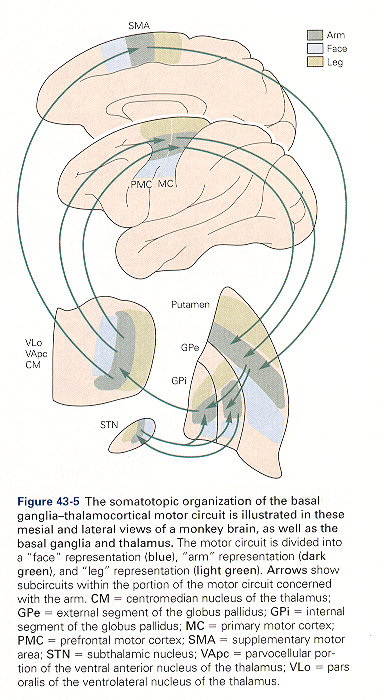
Oculomotor circuit
Frontal and Supplementary eye fields (FEF & SEF) –> caudate –> GPI & SNPR –> Thalamus (and Superior colliculus) –> FEF
- Disinhibition by BG output allows movements to occur (does not initiate movements). For example, inactivation of inhibitory action of SNPR does not cause discharge in superior colliculus (i.e. does not elicit eye movements) but releases SC cells from inhibition and, therefore, SC neurons are more likely to be activated by coincident inputs from other sources.
Prefrontal circuit
Prefrontal cortex –> caudate –> GPI/SNPR –> Thalamus –> prefrontal cortex
- Cognitive aspects such as memory triggered movements. Discharge of BG cells are related to remembered visual targets. Also this circuit is related to aspects of memory that are concerned with orientation in space.
- Ability to make changes in behavioral set (the general readiness and preparation for specific actions).
Limbic circuit
Limbic cortex –> caudate –> GPI/SNPR –> Thalamus –> limbic cortex
- Limbic association areas link motivation and emotions to the execution of movement.
Basal ganglia disorders
Hyperkinesia
Ballism and chorea are two common hyperkinetic disorders. Ballism occurs after lesions of the STN and is characterized by uncontrollable rapid movements of the contralateral arm and leg. Lesions of the STN result in a loss of excitatory drive to the GPI and SNPR –> reduced inhibitory output of the BG –> release extra, unwanted movement.
Chorea is a major symptom of Huntington’s disease. Degeneration of the striatal neurons of the indirect pathway result in less inhibition of GPE cells –> increased inhibition of the STN. The effect of increased inhibition of STN is similar to STN lesions. Both results in excessive movement.
Hypokinesia
Parkinson’s disease (PD) is the most common disorder of the BG and is an example of a hypokinetic disorder. PD is caused by selective degeneration of the dopaminergic innervation of the striatum from the SNPC. This has two effects:
- Removal of DA excitation to the direct pathway to the GPI, which results in reduced inhibition of GPI
- Removal of inhibition to the indirect pathway via the GPE, which results in excessive inhibition of GPE –> over activity in the STN –> excessive facilitation of the GPI.
Thus, the GPI is overactive because of reduced inhibition through the direct pathway and extra facilitation through the indirect pathway. The extra inhibitory output reduces the excitatory input from thalamic neurons to cerebral cortex and leads to hypokinesia and bradykinesia.
Parkinson’s disease
Symptoms
- Akinesia: poverty of associated and spontaneous movements.
- Face has mask-like expression
- Arms do not swing while walking
- Patients sit or stand motionless
- Tremor: especially of hands (pill-rolling). In early stages of disease this tremor disappears during movements –> rest tremor (frequency: 4-6Hz). In later stages, tremor persists during movement (action tremor, 6-8 Hz).
- Rigidity: In relaxed patients, passive manipulation of joints meets with higher resistance than normal. The increased tone is equally distributed between extensor and flexor muscles (unlike spasticity where flexor tone –> extensor tone) and may be accompanied by phenomenon called cog-wheeling. This is due to superposition of tremor onto the increased muscle tone, giving the examiner the feeling of moving the joint through a ratchet-like device.
- Bradykinesia: slowing of movement, this gives impression of a very deliberate and careful action.
- Postural instability: firm unexpected push to shoulders may easily overbalance patients. Stepping reactions are lost, and there is a failure to throw the limbs out to protect the body during falling. The result is that not only do patients with PD fall more frequently but they also damage themselves more than normal when they do fall. In addition, patients with PD have defective anticipatory postural adjustments.
Clinical management and potential treatments
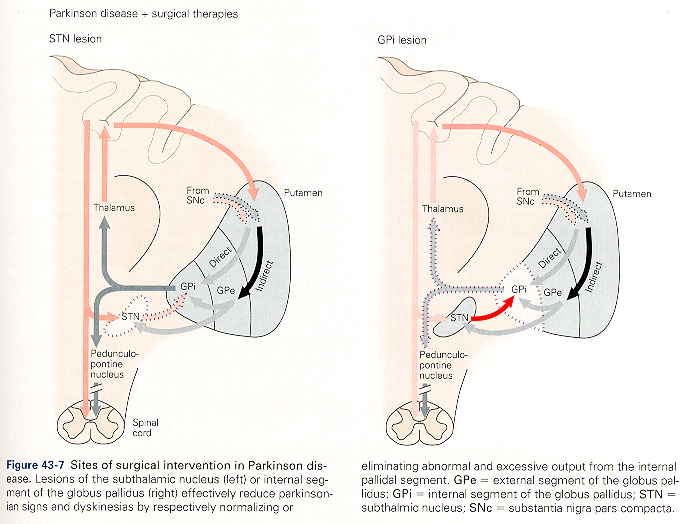
- Increase DA level by administration of L-DOPA, a precursor of DA.
- Implantations of DA rich fetal mesencephalic brain tissue into the striatum of patients.
- Deep brain stimulation
- Stem cells
Strides against Parkinson’s Disease, CBSnews.com, 2/21/2002
Primate model
MPTP is a neurotoxin that, when administered systemically, selectively destroys the dopaminergic cells of the SNPC and causes acute, severe, and irreversible Parkinsonian symptoms. STN lesions in MPTP-induced PD can alleviate most symptoms, including tremor, rigidity, and akinesia. This is an important discovery because of the possibility of developing a new surgical or pharmacological treatment for PD involving inactivation of the STN.

